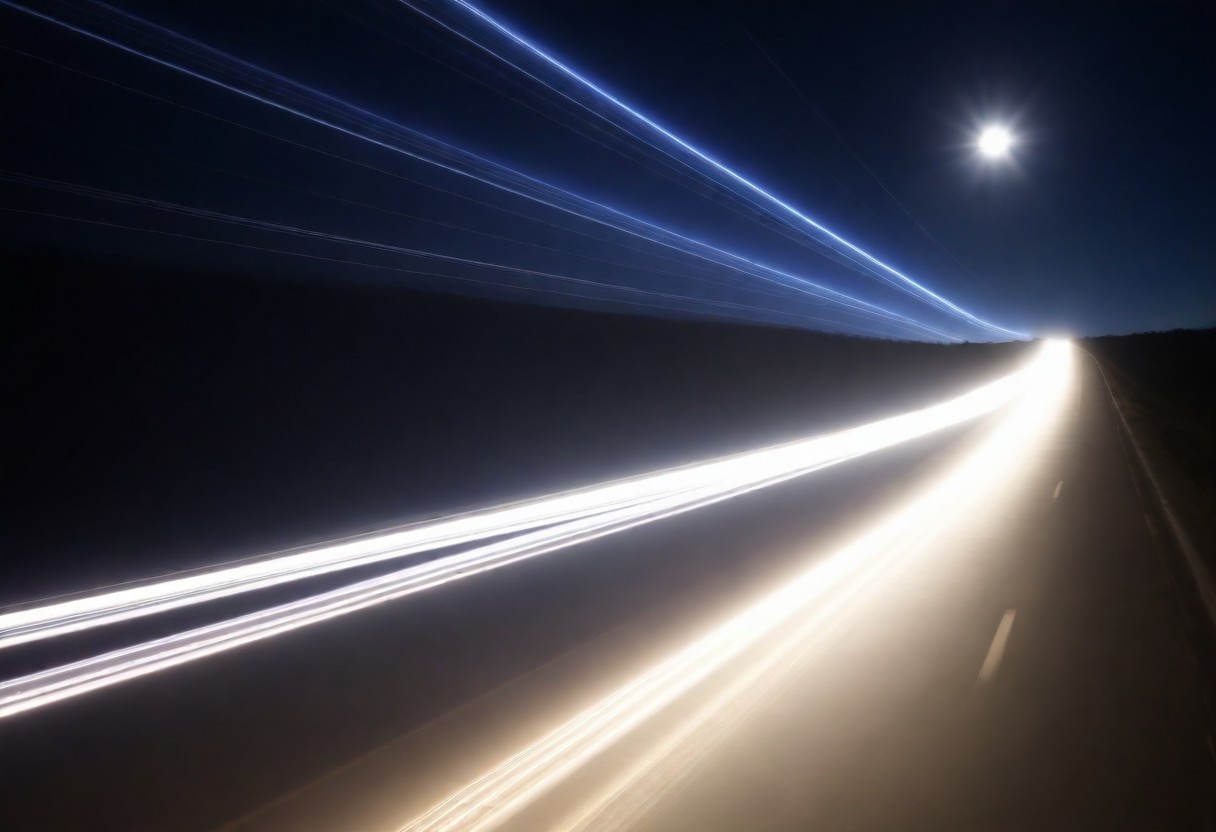The speed of light, denoted by ‘c’ in physics, is one of the fundamental constants of nature. It plays a pivotal role in our understanding of the universe and underpins many of the theories and equations in physics, particularly in the realm of relativity and quantum mechanics. However, measuring the speed of light accurately has been a challenge throughout the history of science. Despite advancements in technology and methodology, several hurdles persist, making the quest for precise measurements an ongoing endeavor.
Historical Context:
Historical inquiries into the speed of light span centuries, with roots extending deep into the annals of scientific exploration. A pivotal moment in this journey occurred during the 17th century, where Danish astronomer Ole Rømer embarked on groundbreaking observations that would forever alter our understanding of the cosmos.
Rømer’s astronomical pursuits led him to study the moons of Jupiter, an endeavor that would unveil remarkable insights into the nature of light itself. As he meticulously tracked the celestial ballet of Jupiter’s moons, Rømer made a curious discovery – the timing of their eclipses seemed to fluctuate over time. Intrigued by this celestial anomaly, Rømer delved deeper into his observations, seeking to unravel the enigmatic forces at play.
After meticulous analysis, Rømer proposed a groundbreaking hypothesis: the observed variations in the timing of Jupiter’s moon eclipses were not arbitrary but rather dictated by the finite speed of light. In essence, Rømer postulated that as Earth moved in its orbit around the sun, the distance between Earth and Jupiter fluctuated, causing a delay in the observed timings of the moon eclipses. This delay, he reasoned, was a consequence of light taking time to traverse the vast expanse of space between the two planets.
Rømer’s groundbreaking insight marked a watershed moment in the quest to measure the speed of light. By attributing the observed phenomena to the finite speed of light, he provided one of the earliest estimates of this fundamental constant, albeit with limited precision. His pioneering work laid the foundation for subsequent explorations into the nature of light and paved the way for the development of more refined measurement techniques in the centuries that followed.
However, Rømer’s achievements did not come without challenges. The tools and methodologies available to him were rudimentary compared to modern standards, limiting the accuracy of his measurements. Additionally, the complex interplay of celestial dynamics posed formidable obstacles, necessitating meticulous observations and meticulous analysis to discern the subtle effects at play.
Despite these challenges, Rømer’s contributions reverberate through the annals of scientific history, serving as a testament to the enduring spirit of inquiry that drives humanity’s quest for knowledge. His pioneering efforts laid the groundwork for future generations of scientists to build upon, propelling the relentless pursuit of precision in the measurement of the speed of light. As we continue to unravel the mysteries of the cosmos, we owe a debt of gratitude to visionaries like Ole Rømer, whose bold insights continue to illuminate the path of scientific discovery.
Methodological Challenges:
Measuring the speed of light stands as a monumental task, requiring not only ingenuity but also meticulous attention to detail. Throughout the annals of scientific inquiry, researchers have devised a myriad of methodologies to tackle this formidable challenge, each method accompanied by its own unique set of hurdles and obstacles.
One of the traditional techniques employed in the pursuit of measuring the speed of light involves timing the interval between the emission and reception of light pulses over known distances. At first glance, this method appears deceptively simple – measure the time it takes for light to travel a specified distance, and voila, the speed of light is revealed. However, delving deeper into the intricacies of this approach unveils a labyrinth of complexities that must be navigated with utmost precision.
A fundamental aspect of this methodology revolves around the synchronization of clocks with high precision. Accurate timing is paramount, as even the slightest deviation in clock synchronization can lead to significant errors in the measurement of light’s speed. Achieving such precision requires sophisticated instrumentation and meticulous calibration, pushing the boundaries of technological capabilities.
Moreover, the journey of light from emission to reception is fraught with potential sources of error, each demanding careful consideration and mitigation. Atmospheric disturbances, for instance, can distort the trajectory of light, introducing inaccuracies into the measurement process. Researchers must contend with factors such as air density, temperature fluctuations, and atmospheric composition, striving to minimize their impact on the integrity of the results.
Instrument limitations further compound the challenges inherent in measuring the speed of light. Optical devices utilized in the experimental setup must possess extraordinary sensitivity and precision to capture the fleeting passage of light accurately. Any imperfections or deficiencies in these instruments can compromise the reliability of the measurements, necessitating rigorous quality control measures to ensure optimal performance.
Beyond technical considerations, human error also looms as a potential obstacle in the quest for precision. Researchers must exercise meticulous care and attention to detail throughout the experimental process, guarding against oversight or oversight that could skew the results. Rigorous experimental protocols and stringent validation procedures are essential to uphold the integrity of the scientific endeavor.
Despite these formidable challenges, the pursuit of measuring the speed of light persists, driven by a relentless quest for knowledge and understanding. With each obstacle encountered and overcome, researchers inch closer towards unraveling the mysteries of the universe, pushing the boundaries of human comprehension. Through ingenuity, perseverance, and unwavering dedication, scientists continue to navigate the methodological challenges inherent in measuring the speed of light, shedding light on one of the fundamental constants of nature.
Innovative Approaches:
In the relentless pursuit of precision, scientists have harnessed the power of technological innovation to devise novel approaches for measuring the speed of light. Among these pioneering techniques, one standout method leverages the remarkable capabilities of lasers and mirrors to create precise optical pathways over vast distances. This innovative approach represents a paradigm shift in the quest for accurate measurements, offering tantalizing prospects for unraveling the mysteries of light’s velocity.
At the heart of this groundbreaking methodology lies the ingenious utilization of lasers as a source of coherent light and mirrors as reflective surfaces. By configuring a series of mirrors spaced kilometers apart, researchers construct an optical pathway along which light beams can traverse with unparalleled precision. The key to this approach lies in the meticulous synchronization of laser pulses and the precise measurement of the time it takes for light to travel between the mirrors and back.
The process unfolds with meticulous precision: a laser pulse is emitted and directed towards the first mirror in the sequence, where it is reflected back towards the source. This pulse of light then continues its journey along the predetermined pathway, bouncing between mirrors separated by precisely calibrated distances. Each round-trip journey provides invaluable data points, allowing researchers to calculate the speed of light based on the precise timing of these optical excursions.
While this method holds the promise of unparalleled accuracy, it is not without its challenges. Environmental factors pose a constant threat to the integrity of the measurements, with fluctuations in temperature, humidity, and atmospheric conditions potentially introducing errors into the data. Researchers must implement rigorous mitigation strategies to minimize the impact of these variables, employing temperature-controlled environments and sophisticated atmospheric monitoring systems to ensure optimal conditions for experimentation.
Instrument calibration also emerges as a critical consideration in the pursuit of precision. The mirrors used in the experimental setup must be meticulously aligned and maintained to minimize deviations in the optical pathways. Any imperfections or misalignments in the mirrors can distort the trajectory of light, compromising the accuracy of the measurements. Thus, researchers devote considerable effort to calibrating and validating the instruments, employing advanced techniques such as interferometry to assess the performance of the optical components with unparalleled precision.
Despite these challenges, the innovative approach of using lasers and mirrors holds immense potential for advancing our understanding of the speed of light. With each technological advancement and methodological refinement, researchers inch closer towards achieving unprecedented levels of accuracy in their measurements. The quest for precision continues unabated, fueled by the relentless pursuit of knowledge and the unwavering commitment to unraveling the mysteries of the cosmos. Through ingenuity, perseverance, and cutting-edge technology, scientists pave the way for new discoveries and insights into one of the fundamental constants of nature: the speed of light.
Relativity and Complexity:
Einstein’s theory of relativity revolutionized our understanding of space, time, and the fundamental nature of the universe. Central to this groundbreaking theory is the concept that the speed of light, denoted by ‘c,’ is an immutable constant in a vacuum, serving as a universal speed limit beyond which nothing can travel. This profound insight fundamentally reshaped our understanding of the cosmos, introducing a new dimension to the measurement of the speed of light and posing intriguing challenges for researchers.
In the realm of relativity, the constancy of the speed of light stands as a cornerstone principle, dictating the fabric of spacetime itself. According to Einstein’s theory, the speed of light remains invariant regardless of the observer’s motion or frame of reference, a concept that defies conventional intuition but has been confirmed through countless experiments and observations. This remarkable property imbues light with a unique status as the ultimate cosmic traveler, setting a cosmic speed limit beyond which no object or information can surpass.
However, the intricacies of relativity extend beyond the simple notion of a constant speed of light, delving into the complex interplay between gravity, spacetime curvature, and the propagation of light. Einstein’s theory predicts that gravitational fields can warp the fabric of spacetime, affecting the trajectory of light rays as they traverse through these warped regions. This phenomenon, known as gravitational lensing, has profound implications for the measurement of the speed of light, particularly in extreme environments such as near black holes or within cosmological contexts.
In regions of intense gravitational fields, such as those surrounding massive celestial bodies like black holes, the fabric of spacetime becomes severely distorted, leading to dramatic effects on the propagation of light. In such environments, the curvature of spacetime can bend light rays, causing them to follow curved trajectories rather than straight lines. As a result, the apparent speed of light may vary depending on the observer’s vantage point, introducing complexities into measurement setups and interpretations.
Moreover, the application of relativity in cosmological contexts further complicates the measurement of the speed of light. In the vast reaches of the cosmos, where galaxies drift apart and spacetime undergoes dynamic evolution, the very fabric of reality is in constant flux. Gravitational interactions between galaxies, the expansion of the universe, and the presence of dark matter and dark energy all contribute to the intricate tapestry of cosmic dynamics, shaping the propagation of light on cosmological scales.
Navigating these complexities requires sophisticated theoretical frameworks and advanced observational techniques. Researchers must account for the effects of gravitational lensing, cosmic expansion, and other relativistic phenomena when measuring the speed of light in extreme environments or cosmological contexts. By integrating insights from relativity with empirical observations, scientists strive to unravel the intricate mysteries of the universe and deepen our understanding of one of its most fundamental constants: the speed of light.
Cosmological Implications:
The speed of light, a fundamental constant of nature, serves as a cornerstone in our quest to unravel the mysteries of the cosmos. Precise measurements of this cosmic speed limit are not merely academic pursuits; they hold profound implications for our understanding of the fundamental properties of the universe and the very nature of reality itself. Delving into the cosmological implications of accurately measuring the speed of light unveils a tapestry of insights that span from the depths of space to the frontiers of theoretical physics.
At the heart of cosmological models lies the intricate interplay between the speed of light and the vast expanse of the universe. By measuring the time it takes for light to traverse cosmic distances, astronomers can infer the spatial dimensions of the cosmos and determine the distances to remote celestial objects. This invaluable information forms the bedrock of our understanding of cosmic structure, allowing us to map out the distribution of galaxies, clusters, and superclusters across the cosmos and trace the cosmic web of cosmic large-scale structure.
Moreover, precise measurements of the speed of light contribute to cosmological models aimed at unraveling the mysteries of the universe’s origins and evolution. By incorporating light’s journey through space and time into theoretical frameworks such as the Big Bang model, scientists can infer the age of the universe and trace its evolutionary history from its primordial beginnings to the present day. This cosmic chronology provides insights into the formation of galaxies, the emergence of cosmic structures, and the evolution of the cosmos on cosmic scales.
However, the implications of measuring the speed of light extend beyond the realm of cosmology, permeating into the fabric of fundamental physics itself. Variations in the speed of light could have profound consequences for our understanding of the fundamental forces and particles that govern the universe. Deviations from the established value of the speed of light could challenge the foundations of Einstein’s theory of relativity and prompt a reevaluation of our understanding of spacetime and gravity.
Furthermore, the quest to measure the speed of light with ever-greater precision has sparked ongoing research and debate within the scientific community. Cutting-edge experiments and theoretical investigations seek to push the boundaries of our knowledge and test the limits of our understanding of the cosmos. From high-precision measurements using advanced instrumentation to theoretical explorations of alternative cosmological models, scientists are continually probing the mysteries of light’s velocity and its implications for our understanding of the universe.
Precise measurements of the speed of light play a pivotal role in shaping our understanding of the cosmos and the fundamental laws that govern it. From elucidating the spatial dimensions of the universe to unraveling the mysteries of its origins and evolution, the cosmic implications of accurately measuring the speed of light are profound and far-reaching. As we continue to push the boundaries of scientific inquiry, the quest to measure the speed of light with unparalleled precision remains a driving force in our exploration of the cosmos and the nature of reality itself.
Future Prospects:
As humanity continues its relentless march toward technological advancement, the future holds boundless promise for refining our ability to measure the speed of light with unprecedented precision. Emerging technologies, driven by innovation and ingenuity, are poised to revolutionize our understanding of light’s velocity and its profound implications for fundamental physics.
One such frontier of exploration lies in the realm of quantum metrology, a cutting-edge field that harnesses the principles of quantum mechanics to push the boundaries of measurement precision. Quantum metrology offers a wealth of potential applications in various scientific domains, including the precise determination of light’s speed. By leveraging quantum phenomena such as entanglement and superposition, researchers aim to develop novel measurement techniques capable of surpassing the limitations of classical methods.
One promising avenue within quantum metrology is the use of atom interferometry, which exploits the wave-particle duality of atoms to measure physical quantities with extraordinary precision. In atom interferometry experiments, atoms are manipulated using laser beams to create interference patterns analogous to those observed in optical interferometers. By precisely controlling the motion of atoms and analyzing their behavior, scientists can obtain highly accurate measurements of quantities such as acceleration, rotation, and—crucially—the speed of light.
Furthermore, the advent of optical lattice clocks represents a paradigm shift in timekeeping and precision measurement. Optical lattice clocks utilize arrays of laser-trapped atoms to create a highly stable and precise reference for timekeeping. By interrogating the atoms’ quantum states with laser light, optical lattice clocks can achieve unprecedented levels of accuracy, rivaling and even surpassing the performance of traditional atomic clocks based on microwave transitions. This remarkable precision opens new possibilities for measuring the speed of light with unparalleled fidelity, providing insights into fundamental physics with implications for fields ranging from cosmology to quantum gravity.
In addition to quantum metrology and optical lattice clocks, advancements in other areas of technology, such as precision optics and ultrafast laser spectroscopy, are poised to further enhance our ability to measure light’s velocity. These technologies enable researchers to manipulate and control light with unprecedented precision, opening new avenues for studying its properties and behavior.
Looking ahead, the future of light speed measurement holds immense promise for unlocking the mysteries of the universe and advancing our understanding of fundamental physics. By harnessing the power of emerging technologies and pushing the boundaries of scientific inquiry, we stand poised to unravel the secrets of light’s velocity and unlock new frontiers in our quest for knowledge. As we continue to push the limits of human understanding, the journey toward precision in light speed measurement promises to illuminate the path toward deeper insights into the nature of reality itself.
In conclusion, Measuring the speed of light remains a formidable challenge despite centuries of scientific inquiry and technological progress. From historical observations to cutting-edge experiments, researchers continue to refine their methods in pursuit of ever-greater precision. Overcoming the various challenges associated with measuring the speed of light not only advances our understanding of the cosmos but also pushes the boundaries of scientific knowledge, inspiring further exploration and discovery in the realms of physics and beyond.










More Stories
Inside the Hormonal Symphony: Understanding the Endocrine System
Understanding Gallstones: Causes, Symptoms, and Treatment Options
The Intricacies of Cells: Exploring the Building Blocks of Life